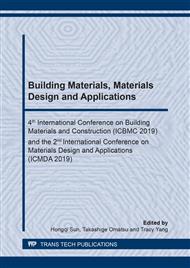[1]
Thai Metereological Department , Annual Weather Summary over Thailand in 2016, (2016).
Google Scholar
[2]
Hiroyuki Tanaka, Jacques Locat, Satoru Shibuya, Tan Thiam Soon,and Dinesh R. Shiwakoti (2001), Characterization of Singapore, Bangkok, and Ariake clays, Can. Geotech. J. 38 (2001),p.378–400.
DOI: 10.1139/t00-106
Google Scholar
[3]
Suksun Horpibulsuk, Satoru Shibuya, Kittitep Fuenkajorn, and Wanchai Katkan , Assessment of engineering properties of Bangkok clay, Can. Geotech. J. 44(2007),p.173–187 ,.
DOI: 10.1139/t06-101
Google Scholar
[4]
Suksun Horpibulsuk , Runglawan Rachan , Apichat Suddeepong , Assessment of strength development in blended cement admixed Bangkok clay, Construction and Building Materials 25 (2011),p.1521–1531.
DOI: 10.1016/j.conbuildmat.2010.08.006
Google Scholar
[5]
Songsuda Vichan, Runglawan Rachan , Chemical stabilization of soft Bangkok clay using the blend of calcium carbide residue and biomass ash, Soils and Foundation 53(2),2013, pp.272-281.
DOI: 10.1016/j.sandf.2013.02.007
Google Scholar
[6]
Chairat Teerawattanasuk, Panich Voottipruex , Suksun Horpibulsuk, Mix design charts for lightweight cellular cemented Bangkok clay, Applied Clay Science 104 (2015) , p.318–323.
DOI: 10.1016/j.clay.2014.12.012
Google Scholar
[7]
Jeerapan Donrak , Runglawan Rachan , Suksun Horpibulsuk , Arul Arulrajah ,Yan Jun Du , Improvement of marginal lateritic soil using Melamine Debris replacement for sustainable engineering fill materials, Journal of Cleaner Production 134 (2016) ,pp.515-522.
DOI: 10.1016/j.jclepro.2015.12.038
Google Scholar
[8]
Itthikorn Phummiphan, Ph.D., Suksun Horpibulsuk, Ph.D., P.E.; Tanakorn Phoo-ngernkham; Arul Arulrajah, Ph.D.; and Shui-Long Shen, Ph.D. (2017), Marginal Lateritic Soil Stabilized with Calcium Carbide Residue and Fly Ash Geopolymers as a Sustainable Pavement Base Material, J. Mater. Civ. Eng., 29(2), (2013).
DOI: 10.1061/(asce)mt.1943-5533.0001708
Google Scholar
[9]
F.G. Bell, Lime stabilization of clay minerals and soils, Engineering Geology 42 (1996), pp.223-237, Elsevier.
DOI: 10.1016/0013-7952(96)00028-2
Google Scholar
[10]
Jonathan Dungca, Julie Ann Lim Jao , Strength and Permeability Characteristics of Road base materials blended with fly ash and bottom ash, International Journal of GEOMATE, Vol. 12, 2017, Issue 31, pp.9-15.
DOI: 10.21660/2017.31.6508
Google Scholar
[11]
Bahram Ta'negonbadi, Reza Noorzad, Stabilization of Clayey Soil using Lignosulfonate, Transportation Geotechnics 12 (2017), pp.45-55.
DOI: 10.1016/j.trgeo.2017.08.004
Google Scholar
[12]
Shanram Porakbar, Afsin Asadi ,Bujhang B.K. Huat, Mohammad Hamed Fasinhikotalab, Stabilization of clayey soil using ultrafine palm oil fuel ash (POFA) and cement, Transportation Geotechnics 3 (2015), p.24–35.
DOI: 10.1016/j.trgeo.2015.01.002
Google Scholar
[13]
Apichit Kampala, Suksun Horpibulsuk,Nuttachai Prongmanee, Avirut Chinkulkijniwat, Influence of Wet-Dry Cycles on Compressive Strength of Calcium Carbide Residue-Fly Ash Stabilized Clay, J.Mater.Civ Eng.,2014,26(4):pp.633-643.
DOI: 10.1061/(asce)mt.1943-5533.0000853
Google Scholar
[14]
Chayakrit Phetchuay , Suksun Horpibulsuk, Cherdsak Suksirioattanapong, Avirut Chinkulkijiwat, Calcium carbide residue: Alkaline activator for clay-fly ash geopolymer, Construction of Building Materials 69(2014) pp.285-294.
DOI: 10.1016/j.conbuildmat.2014.07.018
Google Scholar
[15]
Sakonwan Hanjitsawan, Tanakorn Phoo-ngernkham, Nattapong Damrongwiriyanupap, Comparative study using Portland cement and calcium carbide residue as apromoter in bottom ash geopolymer, Construction and Building /materials 133(2017) , pp.128-134.
DOI: 10.1016/j.conbuildmat.2016.12.046
Google Scholar
[16]
ASTM, ASTM C 618 – 05,Standard Specification for Coal Fly Ash and Raw or Calcined Natural Pozzolan for Use in Concrete, West Conshohocken, PA, USA, 2005: ASTM International.
DOI: 10.1520/c0618-00
Google Scholar
[17]
G.N. Obuzor , J.M. Kinuthia, R.B. Robinson, Soil stabilisation with lime-activated-GGBS—A mitigation to flooding effects on road structural layers/embankments constructed on floodplains, Engineering Geology 151 (2012), p.112–119.
DOI: 10.1016/j.enggeo.2012.09.010
Google Scholar
[18]
Wei-Hsing Huang(1990), The use of bottom ash in highway embankments, subgrades, and subbases, Joint Highway Research Project,Project No.: C-36-501,File No. : 6-19-9.
DOI: 10.5703/1288284314179
Google Scholar
[19]
Aminaton Marto & Choy Soon Tan (2016), Properties of Coal Bottom Ash from power plants in Malaysia and its suitability as geotechnical engineering material, Jurnal Teknologi (Sciences & Engineering) 78: 8–5 ,(2016), p.1–10.
DOI: 10.11113/jt.v78.9603
Google Scholar
[20]
ASTM, ASTM D854-02, Standard Test Methods Soil Solids by Water Pycnometer, ASTM International, West Conshohocken, PA, USA, (2002).
Google Scholar
[21]
ASTM, ASTM D 4318-00, Standard Test Methods for Liquid Limit, Plastic Limit and Plasticity Index of Soil, West Conshohocken, PA, USA: ASTM International, (2000).
Google Scholar
[22]
ASTM, ASTM D 422-98, Standard Test Method for Particle-Size Analysis of Soils, West Conshohocken, PA, USA: ASTM International , (1998).
Google Scholar
[23]
ASTM, ASTM D 698-07, Standard Test Methods for Laboratory Compaction Characteristics of Soil Using Standard Effort (12 400 ft-lbf/ft3 (600 kN-m/m3)), West Conshohocken, PA, USA: ASTM International, (2007).
DOI: 10.1520/d0698-07
Google Scholar
[24]
ASTM, ASTM D 5102-96, Standard Test Method for Unconfined Compressive Strength of Compacted Soil-Lime Mixtures, West Conshohocken, PA,USA: ASTM International, (1996).
DOI: 10.1520/d5102-09
Google Scholar
[25]
K. Rangaswamy, Influence of burnt ash additives on stabilization of soft clay soils, Infrastructure. Solut (2016) ,pp.1-25.
DOI: 10.1007/s41062-016-0025-8
Google Scholar
[26]
Yahia E. A. Mohamedzein, Mohammed Y. Al- Aghbari, Ramzi A. Taha, Stabilization of desert sands using municipal solid waste incinerator ash, Geotechnical and Geological Engineering 24 ( 2006) , pp.1767-1780.
DOI: 10.1007/s10706-006-6806-7
Google Scholar


